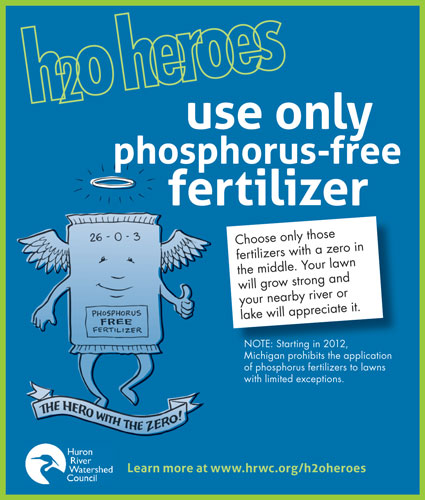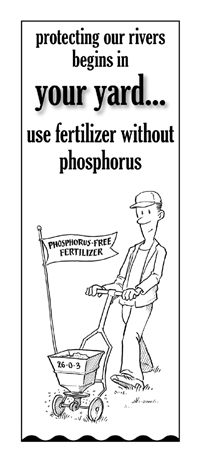Reduce the unnecessary application of phosphorus to lawns, and reduce pollution in the river!

Phosphorus is naturally abundant in the soils of southeast Michigan. Water runoff from fertilized residential lawns is the primary source of phosphorus contaminants entering the Huron River. During normal lawn watering or natural rain storms, unnecessary phosphorus washes into the storm drains. These empty into local streams and the Huron River, without filters or treatment. If you own waterfront property, it can wash directly into the adjacent waterbody directly or is carried by eroding soil.
Phosphorus contributes to excessive aquatic plant growth, nuisance algal blooms and decreased oxygen levels in our freshwater lakes, rivers and streams.
Starting in January 2012 a new Michigan Law, Public Act 299 of 2010, took effect. It prohibits the application of fertilizers containing phosphorus to turf grass (with exceptions). MORE INFORMATION.
Many communities have local ordinances in place (City of Ann Arbor, Pittsfield Charter Township, City of Ypsilanti and Ypsilanti Township in Washtenaw County, Hamburg Township in Livingston County and Commerce and West Bloomfield Townships in Oakland County). Read more about it in the brochure below.
How to Identify Phosphorus-Free lawn fertilizer.
On the outside of product packaging you will see a sequence of three numbers. The first number indicates nitrogen content, which promotes top growth on plants. The middle number indicates phosphorus, for root growth. The last number indicates potassium, for producing strong stems and resistance to disease. If you are looking for a phosphorus-free fertilizer, the middle number must read “0”. As a general rule, look for turf grass fertilizers with zero phosphorus and avoid lawn and garden fertilizers, which are very high in phosphorus.
More River-Friendly Lawn Care Tips
Make a clean sweep.
Keep fertilizer on the lawn and off hard pavement. Immediately sweep up any spills, especially on sidewalks and driveways, and clean those surfaces with a broom not a hose. Never apply fertilizer right before a rain storm. Fertilizer that washes away from your sidewalks, driveway, and lawn enters the storm drain system, which directly connects to local creeks and the Huron River.
Apply less fertilizer, less often.
If you fertilize your lawn once each year, fall is the best time. In the fall, fertilizer can help your lawn repair itself from summer damage and prepare for optimal growth in the spring. In all cases, only apply fertilizer during warmer months when your lawn is no longer subject to freezing temperatures, generally April 1-November 15.
Create a “no fertilizer” zone.
Avoid applying fertilizer within 25 feet of any wetland, stream, waterway or stormwater retention or detention basin.
Put your lawn to work.
Maintain the lawn at a minimum height of three inches and, when you mow, cut no more than one-third of the height of the grass. Taller grass has a deeper, healthier root system, is more tolerant of drought, and resists weed infestation.
When you mow, mulch the clippings back into the lawn. This adds nitrogen and organic matter to the soil, and prevents compaction (thatch). Clippings that are mulched and returned to the lawn all season can contribute up to 25 percent of a lawn’s seasonal fertilizer needs. More tips at Grow a Healthy Lawn.
Get your soil tested.
Learn what your lawn and garden need for optimum health and growth. The Michigan State University Extension Bookstore has Mail-In Soil Test Kits available for purchase.
To use the Soil Test Kit, you follow the directions provided, digging up soil samples from your yard and mailing them to the University Extension service where they are analyzed. You will receive an email directing you to the MSU Soil Test website when your results are available. You will learn the optimum nutrients needed in a fertilizer for your particular soil.
Simply following the general directions listed by the manufacturer on a package of commercial fertilizer can lead to overapplication of the products, and, for soils in this region, excess phosphorus application. Excess phosphorus, nutrients, and pesticides that are washed off fertilized yards along with stormwater causes problems when they make their way into our creeks and rivers. Soil testing also helps watershed residents determine exactly what nutrients are needed, which saves time and money for the homeowner.
Useful Resources
- Healthy Lawns and Gardens Program of the Southeastern Oakland County Water Authority has a website of information and resources for homeowners on water-friendly fertilizing practices.
- Responsible Fertilizer Practices for Lawns is a report of the University of Minnesota Extension Service, division of “Turfgrass Management for Protecting Water Quality.”




